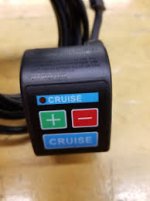I bought several of these (NOS) from a local bike shop. The 3640 and 4840 boards (EB212-A-5 ) and components seem identical except for one of the two power resistor (10w?). I assume it controls the LVC. 300ohm for the 3640; 330ohms for the 4840. Question #1: Can I change that resistor to make a 3640 into a 4840 or is more required?
I'm limited to 18 volt multiples (tool batteries) and use 54V batteries with 48volt controllers with no problems other than the LVC is lower than ideal. Question#2: Could I change Clyte controllers to a defacto 5440 with by changing that resistor to something higher?
I'm using the 4840 controller on a tandem that previously had a 30amp max. KT controller (died) with the LCD3 display/programmer. The KT setup with 5 power levels and automatic cruise control work very well for our style of riding. Level 1 in cruise would hold 20mph on flat with pedaling using less than 300w and automatically increase to 1000w as the bike slowed for the hill climbs. Downhill in cruise, the power used would drop to zero and resume to less than 300w on the flat. In Level 5, 30mph on the flat was no problem if needed.
The Clyte 4840 has a 3 speed switch, a more sophisticated cruise control and works better in all situations except one. Hill climbing; too much power. Both the 3 speed switch and the cruise control limit power only after a certain speed is reached. Climbing a long grade immediately pushes the power to 40-45 amps even in the low switch position and min. cruise setting. I can lower the power by holding the throttle in a mid position with cruise off, but that's difficult to do when busy with hard pedaling and frequent gear changing. Climbing a long steep hill at 20mph is a bad trade off for shortened range and heat build up in components and possible melt down.
I'd rather not use a CycleAnalyst. A little expensive to put on several bikes and it takes a lot of space on the handlebars. I prefer a simple watt meter and cell phone for speed and navigation.
Question #3: How can I limit or control the power output of the 4840 to 20-25 amps during 12 to 15 mph long climbs?
My ideas:
1. Permanent reduction of max. amps: Change or reduce the diameter of power shunts. The opposite of coating shunts with solder to fool controller into more power.
2. Some how adding a variable resistor to the throttle input. I assume cruise control would try go to max throttle voltage, but I think the pot would limit that.
Any ideas or comments would be appreciated.
I'm limited to 18 volt multiples (tool batteries) and use 54V batteries with 48volt controllers with no problems other than the LVC is lower than ideal. Question#2: Could I change Clyte controllers to a defacto 5440 with by changing that resistor to something higher?
I'm using the 4840 controller on a tandem that previously had a 30amp max. KT controller (died) with the LCD3 display/programmer. The KT setup with 5 power levels and automatic cruise control work very well for our style of riding. Level 1 in cruise would hold 20mph on flat with pedaling using less than 300w and automatically increase to 1000w as the bike slowed for the hill climbs. Downhill in cruise, the power used would drop to zero and resume to less than 300w on the flat. In Level 5, 30mph on the flat was no problem if needed.
The Clyte 4840 has a 3 speed switch, a more sophisticated cruise control and works better in all situations except one. Hill climbing; too much power. Both the 3 speed switch and the cruise control limit power only after a certain speed is reached. Climbing a long grade immediately pushes the power to 40-45 amps even in the low switch position and min. cruise setting. I can lower the power by holding the throttle in a mid position with cruise off, but that's difficult to do when busy with hard pedaling and frequent gear changing. Climbing a long steep hill at 20mph is a bad trade off for shortened range and heat build up in components and possible melt down.
I'd rather not use a CycleAnalyst. A little expensive to put on several bikes and it takes a lot of space on the handlebars. I prefer a simple watt meter and cell phone for speed and navigation.
Question #3: How can I limit or control the power output of the 4840 to 20-25 amps during 12 to 15 mph long climbs?
My ideas:
1. Permanent reduction of max. amps: Change or reduce the diameter of power shunts. The opposite of coating shunts with solder to fool controller into more power.
2. Some how adding a variable resistor to the throttle input. I assume cruise control would try go to max throttle voltage, but I think the pot would limit that.
Any ideas or comments would be appreciated.


